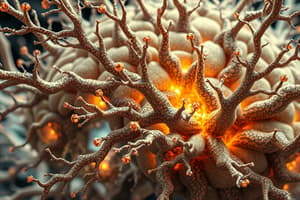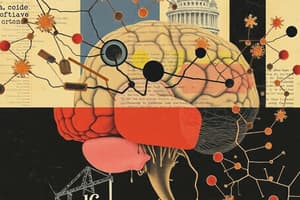Podcast
Questions and Answers
What role do vesicles play in neurotransmission?
What role do vesicles play in neurotransmission?
- They store neurotransmitters until they are released. (correct)
- They initiate the action potential.
- They are involved in receptor binding.
- They act as channels for neurotransmitters.
What is the significance of receptor location in neural communication?
What is the significance of receptor location in neural communication?
- The function of receptors can vary based on their location. (correct)
- Location determines the type of neurotransmitter that can bind.
- Receptors only function in specific areas of the brain.
- Location has no impact on receptor function.
Which of the following neurotransmitters is primarily associated with enhancing mood?
Which of the following neurotransmitters is primarily associated with enhancing mood?
- Norepinephrine
- Dopamine
- Acetylcholine
- Serotonin (correct)
How does an action potential affect neurotransmitter release?
How does an action potential affect neurotransmitter release?
Which neurotransmitter is associated with the body's stress response and alertness?
Which neurotransmitter is associated with the body's stress response and alertness?
Which of the following is the primary inhibitory neurotransmitter in the brain?
Which of the following is the primary inhibitory neurotransmitter in the brain?
Which neurotransmitter is NOT considered a monoamine?
Which neurotransmitter is NOT considered a monoamine?
What is the role of dopamine in the reward system of the brain?
What is the role of dopamine in the reward system of the brain?
Which of these drugs is classified as a GABA agonist?
Which of these drugs is classified as a GABA agonist?
Dopamine is primarily produced in which of the following brain regions?
Dopamine is primarily produced in which of the following brain regions?
Which of the following statements about dopamine receptors is incorrect?
Which of the following statements about dopamine receptors is incorrect?
The neurotransmitter GABA can act on which types of receptors?
The neurotransmitter GABA can act on which types of receptors?
Which statement best describes a common characteristic of addictive drugs?
Which statement best describes a common characteristic of addictive drugs?
What is the primary function of ionotropic receptors?
What is the primary function of ionotropic receptors?
Which of the following neurotransmitter systems primarily uses glutamate as its neurotransmitter?
Which of the following neurotransmitter systems primarily uses glutamate as its neurotransmitter?
How do metabotropic receptors primarily differ from ionotropic receptors?
How do metabotropic receptors primarily differ from ionotropic receptors?
What role do autoreceptors play in neurotransmission?
What role do autoreceptors play in neurotransmission?
Which of the following drugs primarily acts as a glutamate antagonist?
Which of the following drugs primarily acts as a glutamate antagonist?
What is a common method for neurotransmitter clearance in the synaptic cleft?
What is a common method for neurotransmitter clearance in the synaptic cleft?
Which type of receptors does glutamate primarily bind to?
Which type of receptors does glutamate primarily bind to?
Which characteristic distinguishes agonists from antagonists in neurotransmitter systems?
Which characteristic distinguishes agonists from antagonists in neurotransmitter systems?
What role does dopamine play in the brain?
What role does dopamine play in the brain?
Which neurotransmitter is known to originate from the locus coeruleus?
Which neurotransmitter is known to originate from the locus coeruleus?
What effect does norepinephrine have on memory?
What effect does norepinephrine have on memory?
Which of the following receptor types does norepinephrine act on?
Which of the following receptor types does norepinephrine act on?
Which statement correctly describes the function of propranolol?
Which statement correctly describes the function of propranolol?
What is the precursor to serotonin?
What is the precursor to serotonin?
How many receptor types does serotonin have?
How many receptor types does serotonin have?
Selective Serotonin Reuptake Inhibitors (SSRIs) are primarily used to treat which condition?
Selective Serotonin Reuptake Inhibitors (SSRIs) are primarily used to treat which condition?
What is the primary mechanism of action of Prozac (fluoxetine) in treating depression?
What is the primary mechanism of action of Prozac (fluoxetine) in treating depression?
What is a significant finding related to the efficacy of SSRIs for treating mild to moderate depression?
What is a significant finding related to the efficacy of SSRIs for treating mild to moderate depression?
What are hallucinogens, such as LSD or psilocybin, primarily known for?
What are hallucinogens, such as LSD or psilocybin, primarily known for?
What is the role of acetylcholine in the body?
What is the role of acetylcholine in the body?
Which neurotransmitter system do exogenous opioids mimic?
Which neurotransmitter system do exogenous opioids mimic?
What is the primary effect of THC on the neurophysiological level?
What is the primary effect of THC on the neurophysiological level?
Which statement about adenosine is true?
Which statement about adenosine is true?
What distinguishes the effects of psychedelics from traditional antidepressants?
What distinguishes the effects of psychedelics from traditional antidepressants?
Flashcards are hidden until you start studying
Study Notes
Receptors
- Two basic types of receptors: ionotropic and metabotropic.
- Ionotropic receptors are ligand-gated ion channels that open when a neurotransmitter binds to them.
- Metabotropic receptors are G-protein-coupled receptors that trigger a cascade of intracellular signals.
- Receptor location determines its function: postsynaptic receptors receive signals from presynaptic neurons and presynaptic receptors, such as autoreceptors and heteroreceptors, regulate neurotransmitter release.
Receptor Types
- Ionotropic receptors:
- Also known as ligand-gated ion channels.
- Can be excitatory (depolarizing), causing EPSPs, or inhibitory (hyperpolarizing), causing IPSPs.
- Fast and transient effects.
- Metabotropic receptors:
- Also known as G-protein-coupled receptors.
- Modulate cellular activity and signal transduction.
- Slow and longer-lasting effects.
- Often lead to signal cascades within the cell.
Neurotransmitter Clean-up
- Three main types of neurotransmitter clean-up:
- Diffusion: Neurotransmitters diffuse away from the synapse.
- Enzymatic degradation: Enzymes break down neurotransmitters.
- Re-uptake: Neurotransmitters are reabsorbed by presynaptic neurons or astrocytes.
Drug Types
- Agonists: Drugs that mimic the effects of neurotransmitters by binding to and activating their receptors.
- Antagonists: Drugs that block the effects of neurotransmitters by binding to their receptors without activating them.
- More complex drug action: These can include transporter blockers, reuptake inhibitors, and enzyme inhibitors.
Major Groups of Neurotransmitters
- Amino acid neurotransmitters:
- Glutamate: Primary excitatory neurotransmitter.
- Ionotropic receptors: AMPAR, NMDAR, Kainate receptor.
- Metabotropic receptors: mGluR 1-8.
- GABA: Primary inhibitory neurotransmitter.
- Ionotropic and metabotropic receptors.
- Glutamate: Primary excitatory neurotransmitter.
- Monoamine neurotransmitters:
- Dopamine:
- Involved in motivation, movement, learning, and arousal.
- Projects from the substantia nigra pars compacta and ventral tegmental area (VTA) to various brain regions.
- Five receptor subtypes, all metabotropic.
- Not the "pleasure molecule."
- Norepinephrine:
- Both a hormone and neurotransmitter.
- Involved in wakefulness, arousal, and memory enhancement.
- Originates in the locus coeruleus.
- Two main receptor types (⍺1-2, β1-3) with subtypes.
- Plays a role in heterosynaptic facilitation.
- Serotonin:
- Involved in mood, sleep, and cognition.
- Originates in the raphe nuclei.
- 15 receptor subtypes, almost all metabotropic.
- Not simply a "mood molecule."
- Dopamine:
- Other small neurotransmitters:
- Acetylcholine:
- The first discovered neurotransmitter.
- Involved in muscle activation and cognitive functions.
- Found at the neuromuscular junction and in the basal forebrain.
- Endocannabinoids:
- Two neurotransmitters: anandamide and 2-AG.
- Involved in pain, appetite, and mood regulation.
- Two receptor subtypes, both GPCRs.
- Exhibit retrograde transmission.
- Adenosine:
- Produced from ATP.
- Involved in sleep, wakefulness, and energy regulation.
- Caffeine is an adenosine receptor antagonist.
- Acetylcholine:
- Large molecule neurotransmitters:
- Endogenous opioids:
- Also known as endorphins.
- Giant peptide neurotransmitters.
- Involved in pain perception, reward, and stress response.
- Mimicked by exogenous opioids (e.g., heroin).
- Endogenous opioids:
Drugs and their Impact on Neurotransmitter Systems
- Glutamate:
- Glutamate antagonists include barbiturates, nitrous oxide, ketamine, and ethanol.
- GABA:
- GABA agonists include benzodiazepines, ethanol, chloroform, and ether.
- Dopamine:
- Addictive drugs directly or indirectly increase dopamine transmission.
- Norepinephrine:
- Propranolol is a norepinephrine receptor antagonist (beta blocker).
- Serotonin:
- SSRIs, like Prozac, are serotonin reuptake inhibitors.
- Hallucinogens like LSD, DMT, and psilocybin are serotonin receptor agonists.
- Acetylcholine:
- Nicotine is an acetylcholine receptor agonist.
- Endocannabinoids:
- THC is a cannabinoid receptor agonist.
- CBD effects are less clear.
- Adenosine:
- Caffeine and theophylline are adenosine receptor antagonists.
- Endogenous opioids:
- Fentanyl and naloxone are exogenous opioids.
Studying That Suits You
Use AI to generate personalized quizzes and flashcards to suit your learning preferences.




